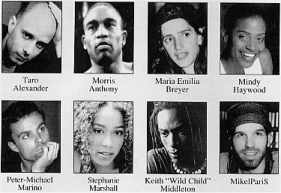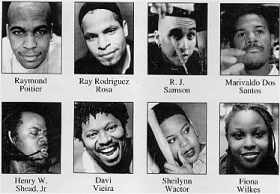STOMP
Stomp Out Paradigms


The New York Cast of STOMP
No, a "paradigm" is not a new Rudiment. According to the American Heritage Dictionary, a paradigm is an "example or pattern that provides a model for a process or system." The term, which has been extremely overused in the business world, is never really discussed in relation to drumming. But if you're looking for fresh drumming ideas, the first thing you should do is get rid of your paradigms.
In other words, set aside your old ways of doing things and try new ideas. Set aside a portion of your daily practice time and try things you haven't done before. Only by opening up your mind and experimenting, can you ever hope to come up with something original.
And speaking of something original, have you ever heard of a theatrical production called STOMP? It consists of a talented group of performers who offer a unique combination of percussion, dancing (closer to stomping), and visual comedy.
The product of a 10-year collaboration between Luke Cresswell and Steve McNicholas, it was first performed on the streets of Brighton, England. The creators of STOMP were originally a group of street performers know as "buskers." (Busking is an old custom in the UK that dates back to booth theaters erected at village fairs in the Middle Ages.)
The theatrical version of STOMP, as it is performed today, first opened in the UK in the summer of 1991. In 1994, it opened in the US at New York's Orpheum Theater where it has won awards for Most Unique Theater Experience. I had the opportunity to catch STOMP at the Orpheum through a field trip with my son's school jazz band (my 11 year old son, Nick, is also a drummer).
Originally, I went to see STOMP strictly for entertainment purposes (and to have a day to hang out in New York's East Village with my son), not to write an article about it. But after seeing STOMP, I realized that it has many ideas and concepts that would be extremely valuable to anyone involved in drumming. So, I offer this article on STOMP to those of you who have yet to see it and to those who have seen it, but may not have realized how to use STOMP's basic concepts to spark your own creativity.
STOMP
The show is performed for 90 minutes straight with no speech, no dialogue, no plot, and without intermission.
Yet, there is not one dull moment throughout.
You're constantly being bombarded with ideas that combine simple, basic rhythmic patterns, with extraordinary "percussion" instruments and sounds of pipes, brooms, lighters, garbage pail lids, garbage cans, matchbooks, and more.
The show opens with a janitor-type dude (or for the politically correct, "custodial engineer") sweeping the floor. He begins to combine the gentle swish of broom bristles with rhythmic taps from the wooden broom head. Soon, he is joined by another broom toting performer, and another, and another, until the stage becomes one big percussion-broom ensemble consisting of rhythmic broom sounds combined with dance steps (foot stomps, actually). And this is just the beginning of what STOMP has in store for you.
The Stranger The Better
There's a segment that has the performers playing totally on matchbooks. Another consists of a four-man
kitchen sink ensemble, complete with water. For this one, the performers have stainless steel kitchen sinks
chained around their necks. Inside each sink each performer has a different size container that they strike
and vary in pitch by filling and emptying with water. At the end is a humorous bit where the male performers
"relieve" themselves!
The STOMP performers play on five gallon water cooler bottles, basketballs become instruments of percussion,
and there's even a segment where three performers strap 40-gallon metal drums on their feet and literally
STOMP around the stage! Many of the percussion instruments played throughout the show are closely integrated
with coordinated foot stomps to complete the rhythmic patterns.
Beyond Pots & Pans
As kids, I guess most future drummers started out by playing on mom's pots and pans. And the idea of using
something other than traditional percussion instruments for ensemble playing is not new. I was playing old car
brake drums and knocking cans off tables on certain beats and weird stuff like that since my days in college
percussion ensemble, playing the "new" music of composers like John Cage (See the Elsewhere on the
Web sidebar). Not that I especially like that kind of percussion music. (What bugs me about some of it, is the
fact that you work hard to perfect complicated drum parts and once you have everybody in the ensemble playing
everything exactly right, it ends up sounding no better than a pile of junk hitting a fan anyway!)
What takes STOMP a step farther than the mere substitution of everyday items like garbage cans and kitchen sinks for actual percussion instruments, is the inclusion of dancing, visual comedy, and audience participation.
The rhythmic patterns used are closely interwoven between performers and depend on each ensemble member to play his or her part in exactly the right place at the right time. If not, the audience will be able to hear the mistakes. To me, that's what separates a real percussion ensemble from one that generates random noise.
What also adds to STOMP's appeal is the audience participation factor. The performers begin by teaching the audience a simple handclap response, which later builds into more and more complex patterns that the audience actually finds itself playing correctly. (Well, MOST of the audience!) Even though I've always considered myself a creative musician, STOMP has given me much food for thought.
A World of Possibilities
No mere article on STOMP can do it justice. You have to experience STOMP for yourself. Once you do, I'm sure
you'll come away with a ton of new ideas to experiment with. Maybe you'll want to add some nontraditional
percussion instruments to your drum kit - if not the whole kitchen sink, maybe just a faucet or two? Or maybe
you'll want to weave some of STOMP's rhythmic ideas into your own drum solo work. If you're into show-style
drum solos, you might even want to include some foot stomping in with your drum patterns or some audience
participation. If STOMP doesn't get your creative juices flowing, then you have none!
By the way, I recommend the STOMP experience for absolutely everyone, young and old, musicians and non-musicians.
STOMP has ongoing performances in New York, San Francisco, and other locations around the US and the world. For more info, see STOMP in the sidebar.
I can't think of a more entertaining or informative way to spend 90 minutes.
Until next time: Stay loose.
